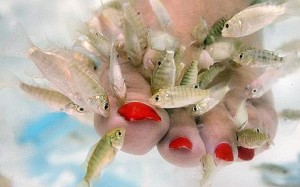Health Protection Agency (HPA) scientists inform us that the risk of infection associated with Garra rufa fish pedicures is likely to be very low.
 |
| [relatedPosts title=”Related Posts”] |
|
|
Following a number of enquiries to the HPA from environmental health practitioners, a multi-agency working group was established to produce guidance for this spa treatment. The working group was led by the HPA and included experts from the HPA, Health Protection Scotland, the Health & Safety Laboratory and local authorities. The guidance has been endorsed by the Chartered Institute of Environmental Health (CIEH) and the Royal Environmental Health Institute of Scotland.
Fish tank water has been shown to contain a number of microorganisms. Therefore, in a fish spa setting there is the potential for transmission of a range of infections, either from fish to person (during the nibbling process), water to person (from the bacteria that can multiply in water), or person to person (via water, surrounding surfaces and fish). However, the overall risk of infection is likely to be very low, if appropriate standards of hygiene are adhered to.
The fish spa working group concluded that those with weakened immune systems or underlying medical conditions, including diabetes and psoriasis, are likely to be at increased risk of infection and so fish pedicures are not recommended for such individuals. The working group advised that operators of fish spas should not promote treatment to these groups.
Dr Hilary Kirkbride, consultant epidemiologist at the HPA, said: “Provided that good standards of hygiene are followed by salons, members of the public are unlikely to get an infection from a fish spa pedicure, however the risk will be higher for certain people.
“This is why we feel it’s important for salons to ensure the client has no underlying health conditions that could put them at risk, and that a thorough foot examination is performed, to make sure there are no cuts, grazes or existing skin conditions that could spread infection.
“Anyone considering a fish pedicure can help reduce the risk of infection – both to themselves and others – by taking simple precautions. Allowing any cuts or infections you may have on your feet or legs to heal before having the treatment, and waiting at least 24 hours after having a leg wax or shaving, will minimise your chances of catching anything. If you do experience any ill effects after the treatment, you should visit your GP.”
Dr Paul Cosford, Director of Health Protection Services at the HPA, added: “As with any beauty salon, it’s really important that strict standards of cleanliness are followed, to ensure that the risk of infection is kept to a minimum. If a member of the public is concerned about the level of cleanliness of a salon they visit, they should report this to their local Environmental Health department.”
Further Information
For more information and guidance on fish spa pedicures, please click here.
To date, the HPA has been made aware of a handful of cases of infection in people who had recently had a fish pedicure. However, foot infections can spread in a variety of environments, and the HPA are unable to say categorically where individual cases of infection were picked up.





